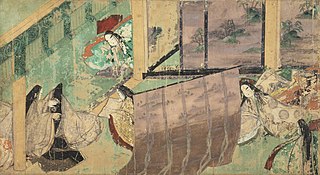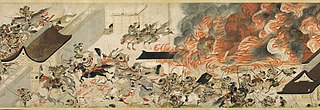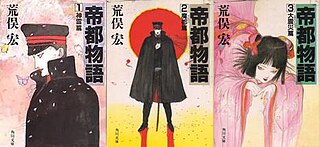 W
WMonogatari is a literary form in traditional Japanese literature – an extended prose narrative tale comparable to the epic novel. Monogatari is closely tied to aspects of the oral tradition, and almost always relates a fictional or fictionalized story, even when retelling a historical event. Many of the great works of Japanese fiction, such as the Genji Monogatari and the Heike Monogatari, are in the monogatari form.
 W
WFūyō Wakashū (風葉和歌集) is a late 13th century collection of poetry from Japanese literature.
 W
WMumyōzōshi is an early 13th-century Japanese text. One volume in length, it is the oldest existing Japanese text on prose literary criticism. The author is unknown, but the leading candidate proposed is Shunzei's Daughter. Other candidates who have been proposed include her maternal grandfather Shunzei himself and the monk Jōgaku (上覚).
 W
WEmakimono or emaki (絵巻) is an illustrated horizontal narration system of painted handscrolls that dates back to the Nara period in 8th century CE Japan, initially copying its much older Chinese counterparts. Japanese scrolls, however, stood out distinctly during the Heian and Kamakura periods; the term "emakimono" therefore refers only to Japanese painted narrative scrolls.
 W
WHamamatsu Chūnagon Monogatari (浜松中納言物語), also known as Mitsu no Hamamatsu (御津の浜松), is an eleventh-century Japanese monogatari that tells about a chūnagon who discovers his father has been reborn as a Chinese prince. He visits his reincarnated father in China and falls in love with the Hoyang Consort, consort to the Chinese Emperor and mother to his reborn father. It is told in six chapters, but the first has been lost to antiquity.
 W
WSoga Monogatari (曽我物語) is a Japanese monogatari, the epic tale of two brothers. It was dramatized based on the vengeance incident, Revenge of Soga Brothers. The story is often known as The (illustrated) Tale of the Soga Brothers or The Revenge of the Soga Brothers. It is sometimes written as Soga Monogatari Zue. It is regarded by some as the last of the Gunki monogatari or great "war tales".
 W
WThe legend of the Straw Millionaire , also known as Daietsu or the Daikokumai, is a Japanese Buddhist folk tale about a poor man who becomes wealthy through a series of successive trades, starting with a single piece of straw. It was likely written during the Heian period and was later collected into Konjaku Monogatarishū and Uji Shūi Monogatari. It became popular during the Muromachi period. It has become a common anecdote in Japanese popular culture.
 W
WThe Taiheiki (太平記) is a Japanese historical epic written in the late 14th century and covers the period from 1319 to 1367. It deals primarily with the Nanboku-chō, the period of war between the Northern Court of Ashikaga Takauji in Kyoto, and the Southern Court of Emperor Go-Daigo in Yoshino.
 W
WThe Tale of Genji is a classic work of Japanese literature written in the early 11th century by the noblewoman and lady-in-waiting Murasaki Shikibu. The original manuscript, created around the peak of the Heian period, no longer exists. It was made in "concertina" or orihon style: several sheets of paper pasted together and folded alternately in one direction then the other. The work is a unique depiction of the lifestyles of high courtiers during the Heian period. It is written in archaic language and a poetic yet confusing style that make it unreadable to the average Japanese speaker without specialized study. It was not until the early 20th century that Genji was translated into modern Japanese by the poet Akiko Yosano. The first English translation was attempted in 1882 but was of poor quality and incomplete.
 W
WThe Tale of Heiji is a Japanese war epic detailing the events of the Heiji Rebellion of 1159–1160, in which samurai clan head Minamoto no Yoshitomo attacked and besieged Kyoto, as part of an Imperial succession dispute, in which he was opposed by Taira no Kiyomori, head of the Taira clan. The Tale, like most monogatari, exists in three main forms: written, oral, and painted.
 W
WThe Tale of Hōgen is a Japanese war chronicle or military tale which relates the events and prominent figures of the Hōgen Rebellion. This literary and historical classic is believed to have been completed in the Kamakura period ca. 1320. Its author or authors remain unknown. The events which are recounted in the Hōgen story become a prelude to the story which unfolds in Tale of Heiji.
 W
WThe Tale of the Bamboo Cutter is a monogatari containing elements of Japanese folklore. Written by an unknown author in the late 9th or early 10th century during the Heian period, it is considered the oldest surviving work in the monogatari form.
 W
WThe Tale of the Heike is an epic account compiled prior to 1330 of the struggle between the Taira clan and Minamoto clan for control of Japan at the end of the 12th century in the Genpei War (1180–1185). Heike (平家) refers to the Taira (平), hei being the Sino-Japanese reading of the first Chinese character and "ke" (家) means family. Note that in the title of the Genpei War, "hei" is in this combination read as "pei" and the "gen" (源) is the first kanji used in the Minamoto clan's name.
 W
WTeito Monogatari is an epic historical dark fantasy/science fiction work; the debut novel of natural history researcher and polymath Hiroshi Aramata. It began circulation in the literary magazine Monthly King Novel owned by Kadokawa Shoten in 1983, and was published in 10 volumes over the course of 1985–1987. The novel is a romanticized retelling of the 20th-century history of Tokyo from an occultist perspective.
 W
WTorikaebaya Monogatari , translated into English as The Changelings, is a Japanese tale from the late Heian period by an unknown author, or possibly more than one author. It is four volumes in length.
 W
WUtsubo Monogatari is a late 10th century Japanese story. It is Japan's oldest full-length narrative.
 W
WYamato Monogatari is a collection of 173 short stories which give details about life in the Imperial court in the 9th and 10th centuries.
 W
WYoru no Nezame is a c. 11th century Japanese story. It is one of the major representative Heian period texts. It is a courtly romance and belongs to the tsukuri monogatari genre.